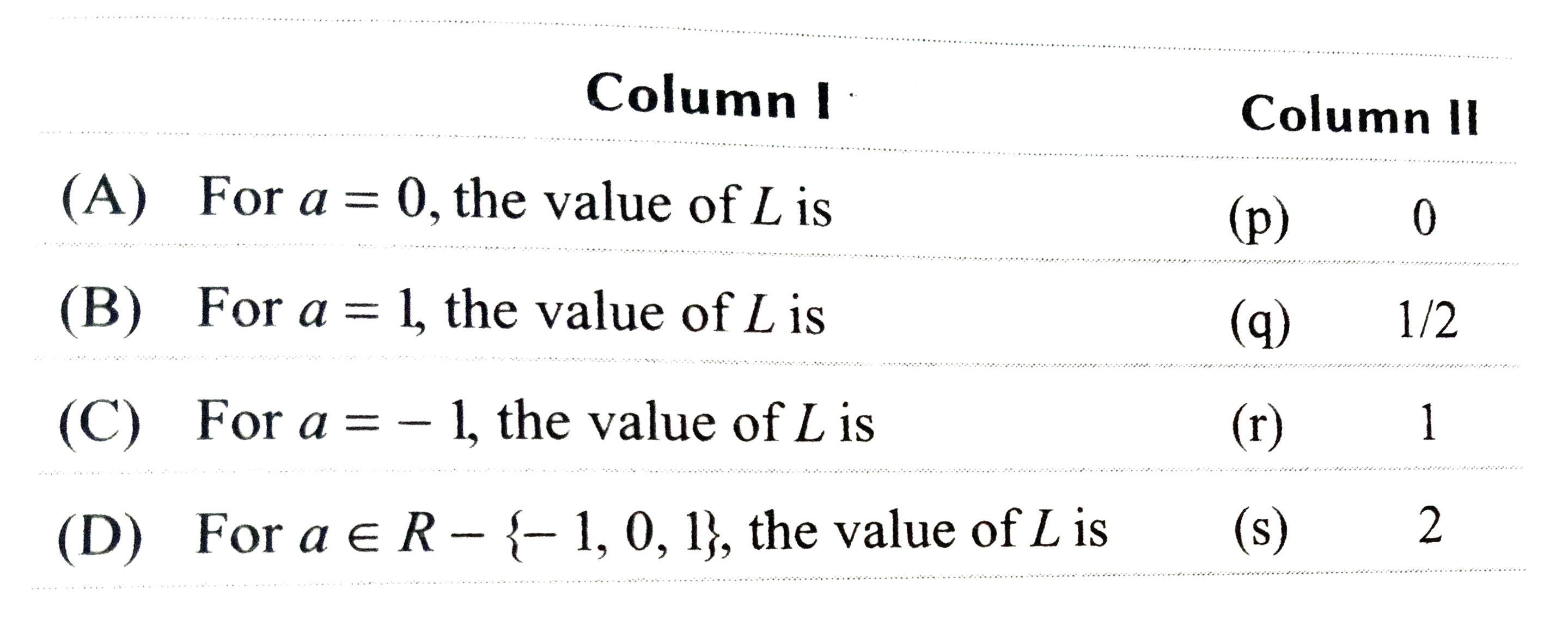Suppose limx→0∫x0t2dt(a+tr)1/pbx−sinx=l,
p∈N,p≥2,a>>0,r>0andb≠0
If p=3andl=1, then the value of 'a' is equal to
8
3
6
3/2
The correct Answer is:A
To solve the given limit problem step by step, we start with the limit expression:
limx→0∫x0t2dt(a+tr)1/p⋅1bx−sinx=l
Given that p=3 and l=1, we need to find the value of a.
Step 1: Evaluate the integral in the numerator
The integral ∫x0t2dt can be calculated as follows:
∫x0t2dt=(t33)x0=x33
Step 2: Substitute the integral back into the limit
Now, substituting the integral back into the limit gives us:
limx→0x33(a+xr)1/3⋅1bx−sinx=1
Step 3: Analyze the denominator bx−sinx
As x→0, we can use the Taylor series expansion for sinx:
sinx≈x−x36
Thus, we have:
bx−sinx≈bx−(x−x36)=(b−1)x+x36
Step 4: Rewrite the limit expression
Now the limit expression can be rewritten as:
limx→0x33(a+xr)1/3⋅((b−1)x+x36)=1
Step 5: Apply L'Hôpital's Rule
Since we have a 0/0 form, we can apply L'Hôpital's Rule. We differentiate the numerator and denominator with respect to x:
- The derivative of the numerator x33 is x2.
- The derivative of the denominator (a+xr)1/3⋅((b−1)x+x36) requires the product rule.
Let u=(a+xr)1/3 and v=(b−1)x+x36.
Using the product rule:
ddx(uv)=u′v+uv′
Step 6: Evaluate the derivatives
1. For u:
u′=13(a+xr)−2/3⋅rxr−1
2. For v:
v′=b−1+x22
Step 7: Substitute back into the limit
Now we substitute back into the limit and evaluate as x→0:
limx→0x2u′v+uv′=1
Step 8: Set up the equation
At x=0:
u(0)=(a)1/3,v(0)=0
This means we need to ensure that:
(b−1)=0⟹b=1
Step 9: Solve for a
Now we have:
limx→0x2(a)1/3⋅(b−1)=1
Substituting b=1 gives us:
limx→0x2(a)1/3⋅0 is undefined, so we need to differentiate again.
After further analysis, we find that:
2(a)1/3=1⟹a=8
Final Answer
Thus, the value of a is:
8
- The derivative of the denominator (a+xr)1/3⋅((b−1)x+x36) requires the product rule.
u′=13(a+xr)−2/3⋅rxr−1
v′=b−1+x22
Topper's Solved these Questions
- DEFINITE INTEGRALBook:ARIHANT MATHS ENGLISHChapter:DEFINITE INTEGRALExercise:Exercise (Matching Type Questions)
Explore 4 Videos
- DEFINITE INTEGRALBook:ARIHANT MATHS ENGLISHChapter:DEFINITE INTEGRALExercise:Exercise (Single Integer Answer Type Questions)
Explore 5 Videos
- DEFINITE INTEGRALBook:ARIHANT MATHS ENGLISHChapter:DEFINITE INTEGRALExercise:Exercise (More Than One Correct Option Type Questions)
Explore 10 Videos
- COORDINATE SYSTEM AND COORDINATES Book:ARIHANT MATHS ENGLISHChapter:COORDINATE SYSTEM AND COORDINATES Exercise:Exercise (Questions Asked In Previous 13 Years Exam)
Explore 7 Videos
- DETERMINANTS Book:ARIHANT MATHS ENGLISHChapter:DETERMINANTS Exercise:Exercise (Questions Asked In Previous 13 Years Exam)
Explore 18 Videos
Similar Questions
Let limT→∞1T∫T0(sinx+sinax)2dx=L, then

View SolutionIf f(x)=∞∑n=1sinnx4nand∫π0f(x)dx=log(mn), then the value of (m+n) is ….
View SolutionIf f(x)=[sin−1(sin2x)] (where, [] denotes the greatest integer function ), then
View SolutionIf a vertex of a triangle is (1, 1) and the mid-points of two side through this vertex are (-1, 2) and (3, 2), then centroid of the triangle is
View SolutionIf a2+b2+c2=−2andf(x)= ∣∣1+a2x(1+b2)x(1+c2)x(1+a2)x1+b2x(1+c2)x(1+a2)x(1+b2)x1+c2x∣∣ , then f(x) is a polynomial of degree 0 b. 1 c. 2 d. 3
View Solutionlimx→0∫x0t2√a+tdtx−sinx=1(a>0). Then the value of a is
View Solutionयदि घटनाएँ A तथा B इस प्रकार है कि P(A)>0 और P(B)≠1 है , तो P(¯¯¯A/¯¯¯B) बराबर होगा
View SolutionSupposelimx→0∫x0t2dt(a+tr)1/pbx−sinx=l,
p∈N,p≥2,a>>0,r>0andb≠0
If l exists and is non- zero, then
View SolutionSuppose ∑x→0∫x0t2dt(a+tr)1/pbx−sinx=l,
p∈N,p≥2,a>>0,r>0andb≠0
If p=2anda=9andl exists , then the value of l is equal to
View SolutionIf two events A and B are such that P(A)>0 and P(B)≠1, then P(¯¯¯A/¯¯¯B) is equal to
View SolutionA and B are two events such that P(A)>0,P(B)≠1 then P(¯¯¯A∣¯¯¯B) is equal to
View SolutionLet x,p∈R,x+1>0,p≠0,1. Then
View Solutionlimx→0∫x0t2√a+tdtx−sinx=1(a>0). Then the value of a is
View SolutionIf A and B are two events such that P(A)>0 and P(A)+P(B)>1, then P(B/A)≥1−P(B')P(A).
View SolutionSupposelimx→0∫x0t2dt(a+tr)1/pbx−sinx=l,
p∈N,p≥2,a>>0,r>0andb≠0
If l exists and is non- zero, then
View SolutionSuppose limx→0∫x0t2dt(a+tr)1/pbx−sinx=l,
p∈N,p≥2,a>>0,r>0andb≠0
If p=2anda=9andl exists , then the value of l is equal to
View Solution
